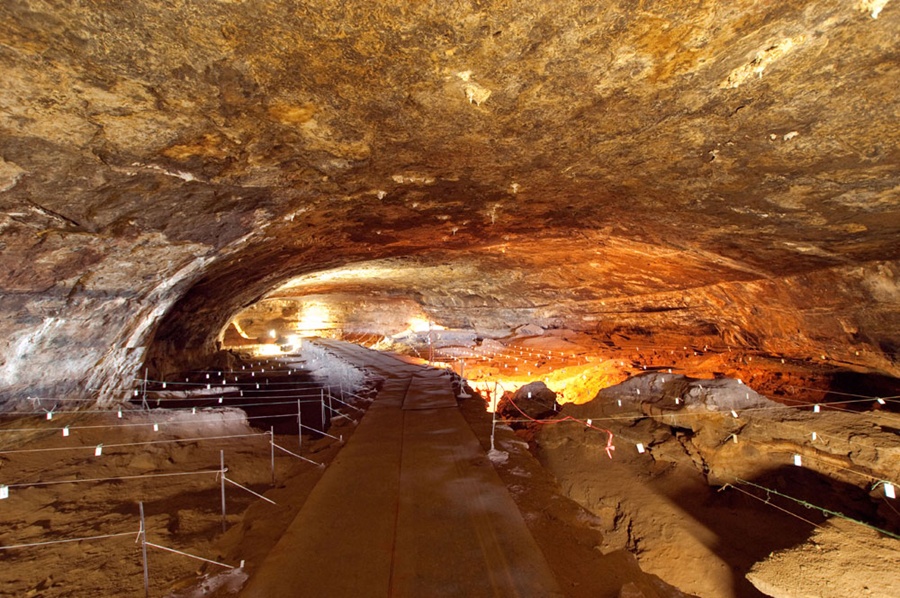10 minutes read!
In the previous article we showed a chronological list of the first hominids fossils discovered on Terra. Today we continue this theme with 3 discoveries published in 2013, that are about the place where fire was used for the first time and other fossils, belonging to some ancestors of today’s humans.
In may 2013 issue, Discover Magazine published information about the Wonderwerk cave from South Africa. Here, archaeologist Paul Goldberg‘s team, accidentally discovered some 1 million year old sediments, that had trails of burning.

Wonderwerk Cave – Greatstock Photographic Library / Alamy
Test on these sediments was applied by one of the Goldberg’s team members, Francesco Berna. He adapted the FTIR test(Fourier transform infrared microspectroscopy), usually used in forensics, for archaeological samples. FTIR consists of analysing material’s composition by measuring the infrared absorption degree. Besides that, the test shows the temperature that the organic matter was heated. By doing so, the sediment sample showed that it was heated between 400-700 Celsius degrees(resembling a barbecue fire). At a closer look on the microscope, Paul Goldberg discovered carbonized leaf, twigs, along with fragments of animal bones. He concluded that the fire was produced inside the cave.
The team will continue digging in this cave, in even deeper layers(1.8 million years) to new find new proof of using fire for the first time.
This year, on 5th of June, Nature published a scientific paper belonging to a team of researchers that discovered the fossils of the earliest primate, unknown until now, on the Yangtze River Valley, Hubei province, China. This primate was then named Archicebus Achilles. The area was placed in time 55 million years ago, in the Eocene. Because this primate was an extremely small creature of about 20-30 grams they needed a technology that permitted to analyze the fossils without destroying them. For this they used a 3D scanner, used on both pieces of rock on which the fossils were discovered. The result can be seen in the next video:
ESRF / Paul Tafforeau
Archicebus differs radically from any other primate, living or fossil, known to science. It looks like an odd hybrid with the feet of a small monkey, the arms, legs and teeth of a very primitive primate, and a primitive skull bearing surprisingly small eyes.
Because of this characteristic it was placed on other branch in the evolution tree. The scientists believe that these fossils shed a light in dividing the branch from which anthropoids emerged (apes and humans) and the branch from which the tarsiers emerged.
In July 2013 the article that announces the oldest inhabitant of Europe, from Orce, Spain is published in Journal of Human Evolution on Science Direct. The oldest human fossil in Europe from Orce unveils the discovery of a molar belonging to a hominid that was dated 1.4 millions years ago.
The Orce region has one of the best late Pliocene and early Pleistocene continental paleobiological records of Europe. It is situated in the northeastern sector of the intramontane Guadix-Baza Basin (Granada, Andalusia, southern Spain). Here we describe a new fossil hominin tooth from the site of Barranco León, dated between 1.02 and 1.73 Ma (millions of years ago) by Electron Spin Resonance (ESR), which, in combination with paleomagnetic and biochronologic data, is estimated to be close to 1.4 Ma.
In the next series we will show information about an Australopithecus and its discoverer, less known to the public.
Sources:
- Discover Magazine – Archaeologists find earliest evidence of humans cooking with fire
- Popular Archaeology – Oldest human fossil in Western Europe found in Spain
- Science Direct – The oldest human fossil in Europe from Orce
- Science Daily – Discovery of oldest primate skeleton, ancestor of humans and apes
- ESRF – Oldest primate fossil rewrites evolutionary break in human lineage
- Nature – The oldest known primate skeleton and early haplorhine evolution
Poți să ne susții cumpărând cărți de la Carturesti, Litera, Librex, Libris, Cartepedia, Librarie.net, Okian.ro, Compania de Librării București, Anticariat-Unu sau Anticexlibris folosind linkurile de mai jos:
- Carturesti
- Litera
- Librex
- Libris
- Cartepedia
- Okian.ro
- Librarie.net
- Compania de Librarii Bucuresti
- Anticexlibris
